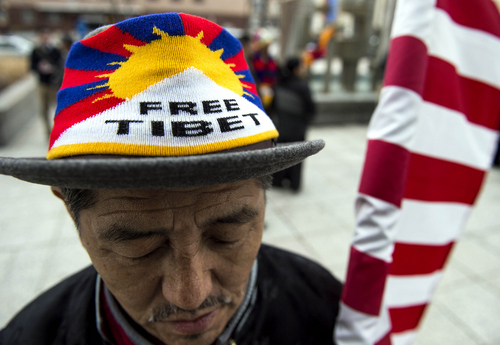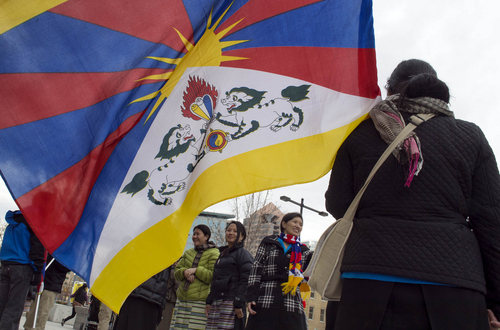This is an archived article that was published on sltrib.com in 2014, and information in the article may be outdated. It is provided only for personal research purposes and may not be reprinted.
Lhaksam Choedon looks forward to the day when her infant son can see a freed Tibet.
Choedon was born in exile in India after her parents and the Dalai Lama fled the Chinese occupation of their home country. She immigrated to Salt Lake City as a child, and though the 27-year-old has spent most of her life here and has never known an independent Tibet, she feels a strong connection to her native country and makes a point to rally for its freedom every March 10.
"Tibetans are still suffering. …" Choedon said, surrounded by dozens of protesters outside the Federal Building in Salt Lake City, after a procession Monday morning from Salt Lake City Hall. "We still haven't forgotten. I don't think we'll ever forget."
The date, National Tibetan Uprising Day, marks the anniversary of an uprising in 1959 when tens of thousands of Tibetans rose up against China's occupation of their Himalayan nation. According to the activist group Rangzen Alliance, about 1.2 million Tibetans have been killed since 1956 from either fighting the occupation, toiling in labor camps or starving from famine. In addition, more than 120 Tibetans have set themselves on fire since 2009 across China, Nepal, India and Tibet to protest China's actions. The self-immolations, nearly all of them fatal, began with Buddhist monks but since have spread to other groups in Tibetan society, including teenagers.
The Salt Lake City protestors bemoaned the slow and steady loss of Tibetan culture, language and identity in their home country under Chinese rule. They no longer call for political independence from China. Rather, they want to see Tibetans enjoy the freedoms of expression, religion and other basic human rights that their counterparts in the United States do.
"[The Tibetan people] still have hope for freedom," said Tenzin Zangma, who was also born in exile.
The March 10 rally, one of many across the globe, has been going on every year in Salt Lake City since about 1992. Chuck Tripp, a retired Westminster College political science professor, has shown up every year for the past 16 years. He and his fellow protestors do not expect to see any immediate results but Tripp feels it is important to support the Tibetan people.
There are about 250 to 300 Tibetans in Salt Lake City, most of whom immigrated in the past 20 years or were born to those immigrants, according to the Utah Tibetan Association.
During the rally, two Tibetan children were playing around an art piece in the Federal Building's courtyard. Choedon hopes the adults can instill the same connection they themselves feel to Tibet in their children so they can keep up the struggle.
Tibetan families try to speak the native language at home, but Choedon would prefer an institutionalized education. Horizonte School used to offer a language class on Saturdays but it was discontinued after a loss of funding, according to protestors.
The Utah Tibetan Association is trying to raise money to open a cultural center that can pick up where Horizonte left off. For more information, visit utahtibetanassociation.org.
Twitter: @mikeypanda





